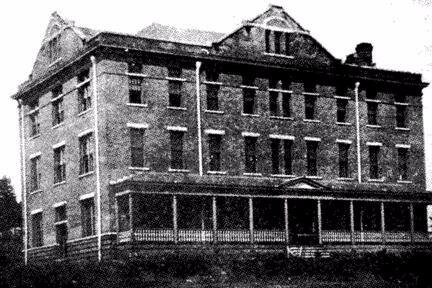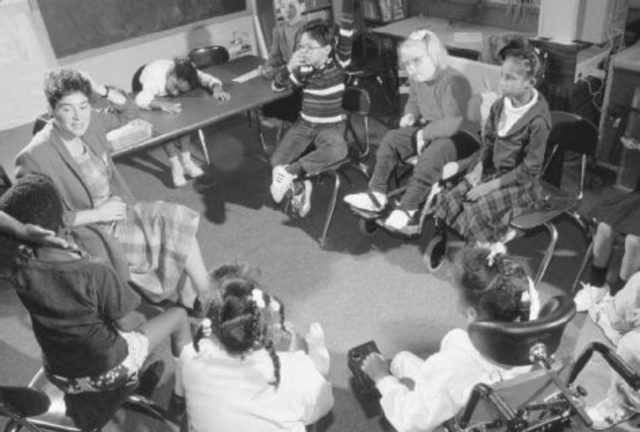-
 The American School for the Deaf (ASD) is not only the oldest permanent school for the deaf in the United States, but it is also the first school for children with any disability in the western hemisphere. It was founded on April 15, 1817, in West Hartford, Connecticut by Thomas Hopkins-Gallaudet, Dr. Mason Cogswell, and Laurent Clerc. It still serves students with hearing impairments to this day. Website
The American School for the Deaf (ASD) is not only the oldest permanent school for the deaf in the United States, but it is also the first school for children with any disability in the western hemisphere. It was founded on April 15, 1817, in West Hartford, Connecticut by Thomas Hopkins-Gallaudet, Dr. Mason Cogswell, and Laurent Clerc. It still serves students with hearing impairments to this day. Website -
 In 1864, the Columbia Institution for the Deaf and Dumb and the Blind, now known as Gallaudet University, was granted permission to give college degrees. This makes it the first college in America to give students with disabilities the opportunity to earn a college degree. The formal recognition of ASL as a language also began here. Gallaudet University continues to serve students with hearing impairments for over 150 years. Website
In 1864, the Columbia Institution for the Deaf and Dumb and the Blind, now known as Gallaudet University, was granted permission to give college degrees. This makes it the first college in America to give students with disabilities the opportunity to earn a college degree. The formal recognition of ASL as a language also began here. Gallaudet University continues to serve students with hearing impairments for over 150 years. Website -
 The Council for Exceptional Children (CEC) was founded in 1922. It became the first professional advocacy organization dedicated to improving the educational experience of students with disabilities. One of its primary goals was to organize and establish professional practice standards as well as ethical principles. This organization still provides continuing education while providing professionals with the necessary resources to provide for their students. Website
The Council for Exceptional Children (CEC) was founded in 1922. It became the first professional advocacy organization dedicated to improving the educational experience of students with disabilities. One of its primary goals was to organize and establish professional practice standards as well as ethical principles. This organization still provides continuing education while providing professionals with the necessary resources to provide for their students. Website -
 Brown v. Board of Education was a court decision that lead to the racial desegregation of schools. This legislation was also instrumental in securing the rights of students with disabilities to public education. As a result of the racial desegregation of schools, the Supreme Court also decided later on that no school should be segregated on the basis of sex, age, or disabilities, either. Website
Brown v. Board of Education was a court decision that lead to the racial desegregation of schools. This legislation was also instrumental in securing the rights of students with disabilities to public education. As a result of the racial desegregation of schools, the Supreme Court also decided later on that no school should be segregated on the basis of sex, age, or disabilities, either. Website -
 This was a lawsuit filed against the District of Columbia. The case resulted in a ruling that stated that students with disabilities must be given a public education even if the students' families are unable to pay for the cost of their child's education. It established that "all children are entitled to a free public education and training appropriate to their learning capacities," essentially establishing the FAPE used today. Website
This was a lawsuit filed against the District of Columbia. The case resulted in a ruling that stated that students with disabilities must be given a public education even if the students' families are unable to pay for the cost of their child's education. It established that "all children are entitled to a free public education and training appropriate to their learning capacities," essentially establishing the FAPE used today. Website -
 As part of the 1973 Rehabilitation Act, Section 504 became the first civil rights law related to disability that was enacted in the United States. This piece of legislation prohibits discrimination against people with disabilities in programs that receive federal funding. Today, it works together with ADA and IDEA to protect both children and adults with disabilities from unequal treatment in schools, jobs, and the community.
As part of the 1973 Rehabilitation Act, Section 504 became the first civil rights law related to disability that was enacted in the United States. This piece of legislation prohibits discrimination against people with disabilities in programs that receive federal funding. Today, it works together with ADA and IDEA to protect both children and adults with disabilities from unequal treatment in schools, jobs, and the community.
Video -
 The Individuals with Disabilities Education Act (IDEA) is a federal law that supports individualized special education and related services for children with disabilities. When it was passed in 1975, it was called the Education of Handicapped Children Act. At the same time, Individualized Education Plans (IEPs) were introduced to schools. Further amendments were added in 1990 when it became known as IDEA and again in 1997 and 2004.
The Individuals with Disabilities Education Act (IDEA) is a federal law that supports individualized special education and related services for children with disabilities. When it was passed in 1975, it was called the Education of Handicapped Children Act. At the same time, Individualized Education Plans (IEPs) were introduced to schools. Further amendments were added in 1990 when it became known as IDEA and again in 1997 and 2004.
Video -
 The Handicapped Children's Protection Act of 1986 builds upon IDEA by mandating that public schools receive financial support from the federal government in order to give children with disabilities full access to all education and food programs. Much like IDEA, it allows parents of children with disabilities to participate in the formation and implementation of the IEP and ensures a free and appropriate public education. Website
The Handicapped Children's Protection Act of 1986 builds upon IDEA by mandating that public schools receive financial support from the federal government in order to give children with disabilities full access to all education and food programs. Much like IDEA, it allows parents of children with disabilities to participate in the formation and implementation of the IEP and ensures a free and appropriate public education. Website -
 The Assistive Technology Act, also known as the Technology-Related Assistance Act of 1988, or the Tech Act, was passed by Congress in 1988. This act was intended to provide access to assistive technology to people with disabilities to help them fully participate in their education, employment, and daily activities. It covers all people with individuals regardless of age, disability, or environment in which the technology will be used. Website
The Assistive Technology Act, also known as the Technology-Related Assistance Act of 1988, or the Tech Act, was passed by Congress in 1988. This act was intended to provide access to assistive technology to people with disabilities to help them fully participate in their education, employment, and daily activities. It covers all people with individuals regardless of age, disability, or environment in which the technology will be used. Website -
 The Americans with Disabilities Act (ADA) of 1990 is a civil rights law that prohibits discrimination against individuals with disabilities in all public and private spaces that are open to the general public. This includes jobs, schools, transportation, and all other places in the community. This law also ensures equal employment opportunities, increases accessibility, and aims to provide those with disabilities with equal treatment.
The Americans with Disabilities Act (ADA) of 1990 is a civil rights law that prohibits discrimination against individuals with disabilities in all public and private spaces that are open to the general public. This includes jobs, schools, transportation, and all other places in the community. This law also ensures equal employment opportunities, increases accessibility, and aims to provide those with disabilities with equal treatment.
Video
